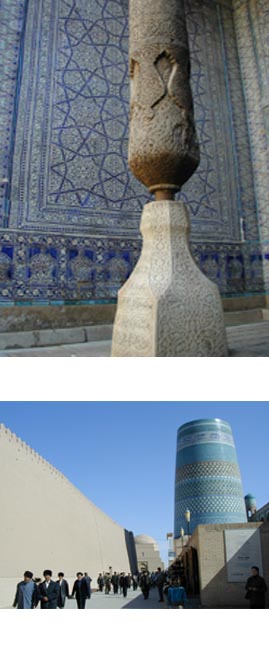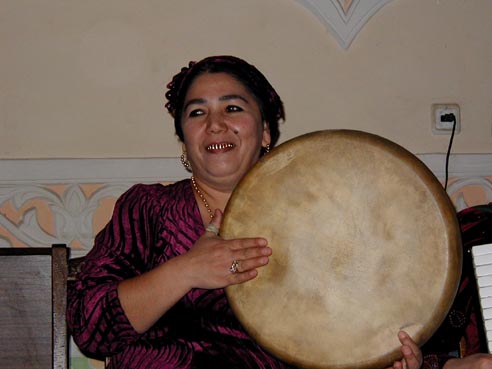|
one surrounds the old city called Inchan
Qala or “Royal City” and is the most visible and the second, surrounds
the Dishon Qala which includes Ichan Qala and provides protection for the
merchants’suburbs. Most of the latter is buried beneath the modern town.
The wall around the old city was built between the 5th and 4th
centuries BC and was about one and a half miles long.
There are many mosques and madrassahs in
the city. Some madrassahs are used as hotels, others for shops. The
Dzhuma Mosque is different in that it has no portals or domes. It can be
entered from three sides. There is a large hall with a ceiling supported
by 213 carved wood columns each about sixteen feet high and ten feet
apart. The columns rest on a stone base with a felt pad separating the
parts and a metal collar to keep the wood dry.
The Kukhna Ark, a fortress residence for
the ruler, housed the Summer Mosque that included a beautiful painted
ceiling. The mint and jail and their histories were also interesting.
The Kalta minaret encircled by bands of
beautiful turquoise designs and appears short and squatty is often
photographed as a symbol of Khiva. Its planned height was 230 – 260 feet,
but construction stopped at 55 feet with the khan’s death in 1855. The
foundation diameter is 46 feet. In comparison, the tallest minaret in
Khiva is 188 feet tall and 31 feet across at its base.
We were entertained by a troop of
aerialists representing three generations in one of the squares. The
older men provided music on native instruments while two men and a boy
performed on the high wire. Forming a human pyramid in the wind provided
additional excitement to the show.
We had supper in a restaurant in the old
city and departed for the airport for our flight to Tashkent. We again
boarded a Russian twin prop airplane, this time an AN 24-B. The seats
could be put in only two positions, “upright” and full forward, so Maria
who was in front of me was leaning back almost into my lap. Another
interesting procedure on these flights in both countries was to wait for
the captain to leave the plane before passengers disembarked. We rode
toward the terminal in a bus, got out, walked to a gate, got our bags from
the baggage cart and went out the gate without going into the terminal.
|



